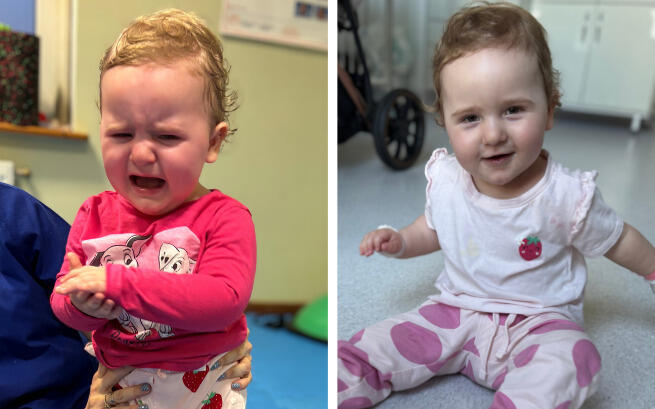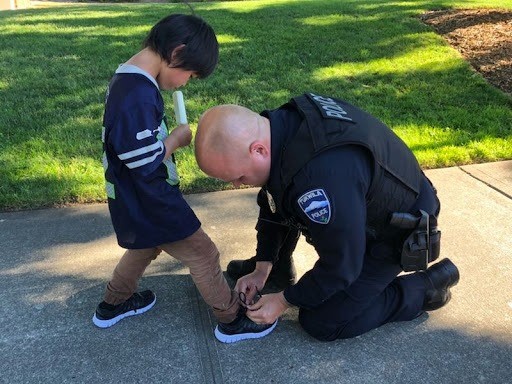A Silent Battle: Iga’s Fight Against Rett Syndrome
When Iga was born, her parents believed they were holding a perfectly healthy baby girl. Her cries, her tiny hands grasping their fingers, her gentle eyes—all of it seemed like the beginning of a beautiful and ordinary childhood. For the first eight months, everything appeared normal. But then, subtle signs began to cast shadows over the joy.
She wasn’t crawling. She wasn’t trying to pull herself up. The milestones that should have been just around the corner never came. Concern quickly replaced comfort. Her parents knew something wasn’t right.

From that moment on, their lives were consumed by a desperate search for answers. Doctors ordered test after test, but every result came back normal. The mystery deepened, the anxiety grew, and the fear of the unknown weighed heavily on the family. Only when they were referred for genetic testing did the devastating truth emerge: their daughter had
Rett syndrome is a rare and cruel genetic disorder that affects almost exclusively girls. It is a thief of childhood, stealing abilities one by one. Children with Rett often lose the ability to walk, to speak, or to use their hands purposefully. They remain locked inside themselves, their thoughts and emotions trapped in silence. For many families, the only connection left is through their child’s eyes—eyes that plead for help in ways words never could.
For Iga’s parents, the diagnosis was nothing short of shattering. “It turned our entire lives upside down,” they admit. “We thought she was healthy. We had no idea that fate would put us to such a test.”
Yet even amid the devastation, there is no room for surrender. Rett syndrome may be relentless, but so is the love of a parent. Iga’s family refuses to give up on her.

Intensive rehabilitation is critical. Specialized therapies can help slow the disease’s progression, preserve mobility, and give Iga the best chance of maintaining quality of life. Medications and treatments can ease symptoms, offering small but important victories in the day-to-day battle. And looming on the horizon is the possibility of
The challenge is that the cost of keeping her stable is astronomical. Therapy sessions, specialized equipment, medications, and travel for treatment abroad all add up to amounts no ordinary family could shoulder alone. Every month brings new expenses, and with them, new worries.
“We are devastated and terrified,” Iga’s parents confess. “The only thing worse than the diagnosis is knowing there is help out there—but we can’t afford it. That’s a parent’s worst nightmare.”
Their plea is not one of resignation, but of determination. They are willing to fight with everything they have, but they cannot win this battle alone.

For Iga, time is everything. Rett syndrome does not wait. With each passing day, the risk of losing more abilities grows. The urgency is heartbreaking: every coin donated, every message of support, every act of kindness buys more time for Iga to hold on until new treatments are available.
This is why her family has turned outward, sharing their story with the world. They are asking not only for financial help but for compassion—for people to stand beside them in the fight to save their little girl.
The truth is, children like Iga remind us of something profoundly human. They show us that strength is not measured in achievements, but in endurance. That love is not defined by ease, but by sacrifice. And that hope, even when fragile, can move mountains when it is shared.
Iga may not be able to speak, but her eyes tell the story. They tell of a child who deserves the chance to live, to be loved, and to dream. They tell of parents who will never stop fighting for her. And they tell us, too, that we each have a part to play in helping her journey forward.
In the end, Rett syndrome may be a powerful enemy, but it is no match for the power of community, compassion, and love. Iga’s parents believe that with enough hands lifting them up, their daughter can hold on long enough to see the day when science offers a cure.
Until then, they will not stop. They will fight with every ounce of strength they have. And they hope that others will join them—because together, the story of Iga’s life does not have to be one of loss, but of resilience, unity, and hope.
A Cry for Help, A Hero’s Answer: Officer’s Brave Act Saves a Life

In the line of duty, police officers are trained to face danger, make quick decisions, and protect the public. But sometimes, their most impactful moments come not from stopping crime, but from saving a single, fragile life. That’s exactly what happened to Officer [Name Withheld], who—after 25 years on the force—experienced the most profound moment of his entire career.
It was just another night shift. The call came in: a child was choking. No more details. No time to waste. The officer responded immediately, racing toward the home where panic had already set in.

Inside the house, the scene was heart-wrenching. A two-month-old baby girl—later introduced to the world as Miss Parham—was turning blue. Her tiny body was limp. Her terrified parents had attempted CPR, desperately trying to revive her, but it hadn’t worked. Every second mattered. Every breath lost was a step closer to tragedy.
When the officer arrived, baby Parham wasn’t breathing. For a moment, the world seemed to stop. Then instinct kicked in.
He didn’t hesitate. Dropping to his knees, he began performing reverse CPR—an emergency technique where the rescuer suctions the blockage from the airway instead of delivering breaths. He worked quickly but gently, praying that it wasn’t too late. And then… it happened.

A small cough. A soft breath. A smile.
And then, the most beautiful sound of all: a cry.
That tiny, piercing wail—the very noise that can drive new parents mad in the middle of the night—was music to the officer’s ears. It meant life. It meant hope. It meant the little girl had come back to them.
That one moment, filled with tension, emotion, and overwhelming relief, became the defining point of his decades-long career.
“I would like to take the time to introduce everyone to Miss Parham,” the officer later wrote in a heartfelt social media post. “She is a two-month-old beautiful baby girl. When I arrived, she was not breathing. I did reverse CPR and was able to suck the cereal out of her throat and she began breathing again. She smiled at me for a second and then started crying—which was music to my ears.”

He went on to say that out of his 25 years of service, this was his greatest and most meaningful accomplishment. “It made every second of those 25 years worth it all,” he wrote. “I am forever humbled and changed by this. Little Miss Parham will forever be a part of my life.”
And truly, how could she not?
In a world where law enforcement officers often face criticism and high-pressure situations, stories like this serve as a powerful reminder of the compassion, humanity, and bravery that exists behind the badge. It wasn’t just a rescue—it was a connection. A split-second decision that saved a life. A quiet act of courage that rippled far beyond that home on that quiet night.

Today, Miss Parham is healthy and safe, thanks to the quick actions of one man who saw not just a call number on a dispatch screen, but a life that mattered.
And somewhere out there, a veteran officer carries a new sense of purpose, knowing that one tiny heartbeat now continues because of what he did.
Sometimes, heroes wear uniforms. Other times, they wear humility, compassion, and the memory of a baby’s cry that changed everything.





